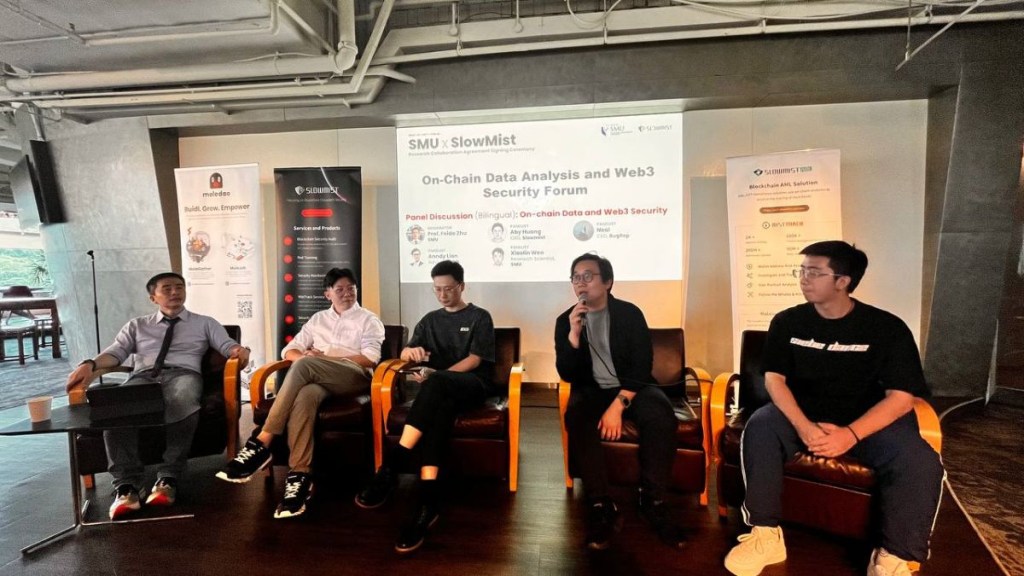By Jenny Zheng
On September 28, 2023, a panel of experts convened at the Singapore Management University (SMU) to delve into the realms of on-chain data and Web3 security. Prof. Feida Zhu, a renowned figure in information systems and co-director of the SMU Blockchain Lab, took the reins as the moderator. The panel featured luminaries including Aby Huang, the CEO of SlowMist, a prominent blockchain security firm; Neal, CEO of BugRap, a decentralized bug bounty platform; Anndy Lian, an advisor at Bybit, a global cryptocurrency exchange; and Xiaolin Wen, a research scientist at SMU.
The panelists explored a range of topics, starting with the role of on-chain data analytics in bolstering blockchain network security. They shared their perspectives on the potential of on-chain data analytics to enhance security measures, detect fraudulent activities, identify vulnerabilities, and effectively communicate findings.
Enhancing Blockchain Network Security
Aby Huang emphasized the real-time benefits of on-chain data analytics in improving security. He discussed its ability to monitor blockchain networks, assess risks, and detect anomalies, such as irregular transactions or suspicious contract calls. Furthermore, he highlighted how on-chain data analytics can evaluate the security of smart contracts, tokens, dApps, and protocols by considering factors like code quality, audit results, governance mechanisms, and community trust.
Neal echoed Aby’s sentiments, underlining how on-chain data analytics promotes transparency and accountability. He explained its role in verifying the correctness and integrity of smart contracts and transactions through cryptographic proofs and consensus mechanisms. Neal also noted that economic models and game theory can be leveraged to incentivize positive behavior while discouraging malicious actions.
Anndy Lian emphasized the importance of feedback and improvement in enhancing security measures. He illustrated how on-chain data analytics measures the performance and efficiency of blockchain networks using key metrics like throughput, latency, scalability, and cost. Additionally, he discussed its potential to pinpoint pain points and bottlenecks in these networks by employing benchmarking and comparative analysis.
Xiaolin Wen concluded that on-chain data analytics contributes intelligence and innovation to blockchain security. He highlighted its ability to uncover new patterns and insights through advanced techniques like machine learning, natural language processing, and graph analysis. Furthermore, he discussed how interdisciplinary approaches, such as cryptography, software engineering, and human-computer interaction, enable the development of novel solutions and applications for blockchain security.
Early Detection of Fraud and Security Breaches
The panelists also shared examples of how on-chain data analytics can facilitate the early detection of fraud and the prevention of security breaches in the blockchain space. Aby Huang described how SlowMist actively monitors and investigates hacking incidents in the blockchain ecosystem, including recent cases like the Mixin incident involving $200 million worth of crypto assets. Anndy Lian emphasized the role of education in promoting security awareness among crypto users, emphasizing the importance of platforms like SlowMist offering free live monitoring to prevent financial losses.
Prof. Feida Zhu offered insights into the future of Web3 security. He predicted that advances in on-chain analytics would lead to proactive security measures, adapting to changing conditions and fostering collaboration among stakeholders. Web3 security, he asserted, would shift from a reactive, static, and isolated model to one that is proactive, adaptive, and collaborative.
Conclusion
The panelists concurred that on-chain data analytics holds unparalleled promise for uncovering transaction intent within the blockchain’s rich data tapestry. Techniques such as graph analysis, network analysis, community detection, and link prediction can illuminate the dynamics of transaction networks. Furthermore, methodologies like game theory, behavioral economics, social psychology, and decision theory can provide insights into the strategies, preferences, and emotions of transaction participants.
This event was organized by Moledao in conjunction with an MOU signing between SMU and SlowMist, exemplifying the collaborative spirit of the blockchain community in advancing Web3 security.
The author is a blockchain specialist








